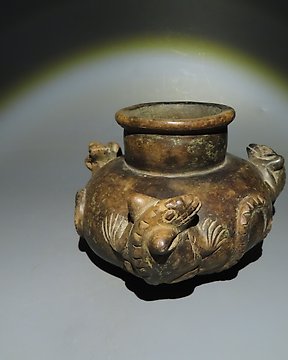
Tairona, Kolumbien Terracotta Schale mit drei Nagetieren. 800 - 1200 n. Chr. 10 cm H. Mit spanischer Importlizenz.
Nr. 84343491

Nr. 84343491

Stirrup-Handle Bowl of a Woman in Labor.
- Very Fine Piece! -
- Thermoluminiscense Test -
CULTURE: Nazca, Perú
PERIOD: 100-400 AD.
MATERIAL: Terracotta
DIMENSIONS: Height 15.5 cm.
CONDITION: Good condition. Intact.
PROVENANCE: Private collection, Virginia, USA. Acquired from Sotheby Parke Bernet, Inc. New York on October 11, 1974. Catalogue 204. Former Loeb collection.
DOCUMENTATION: Thermoluminiscense Test. Spanish Import license included.
DESCRIPTION:
Excellent anthropomorphic vase with a stirrup handle modeled in terracotta with the entire surface covered by a fine slip. The glass presents the peculiarity of having a stylized shape of a human figure. A woman, squatting, in which the head serves as a support for the handle. The hole located on it, as well as the hole in the rear support allow oxygen to circulate inside the container at the time of cooking.
The entire surface presents a light ocher background, with her hair, formed into four braids on each side, and linear details in a dark brown, almost gray tone. The woman's face is clearly in the Nazca style, as well as her pictorial decoration, it presents medallions with jaguar faces in different dimensions, some of them polychrome in red or orange. The woman's arms are drawn on her stomach, her knees protrude from the globular shape as well as her toes, and the female sex is also marked in the lower central part. Given the volume of the vase, the bulging belly and the position of the legs, together with the marking of the sex, it is very likely that it represents a woman in labor.
It is a clear example of the mastery of the Nazca culture in the modeling and decoration of huacos or ceramic vases, as well as playing with symbolism and volumetric forms.
The Nazca Culture developed in the valleys and the southern coast of Peru, including Pisco, Ica, Cañete, Acarí and, especially, the Nazca Valley itself. This area is a coastal desert crossed by narrow fertile valleys.
The best-known artistic expression of the Nazca are the geoglyphs, huge drawings drawn on the pampa north of the Cawachi settlement. There, anthropomorphic, zoomorphic and phytomorphic figures are represented, along with straight lines several kilometers long, all made with a precision that still amazes. The true meaning of these figures is not known, most of which can be better appreciated from the air. One of the main hypotheses proposes that the place was an astronomical observatory, while another postulates that it could have been a great ceremonial center.
Pottery, for its part, stands out for the quality of the vessels, the complex representations that were painted on their surfaces and, especially, for the polychromy of said motifs, with pieces that have up to six or seven colors. The most typical form of the vessels is the bridge-handle bottle with two spouts, on which elements of daily life were represented, such as flowers, fruits, birds, animals and insects, as well as mythological characters or those that combine human attributes. And animals.
The individuals were buried in bundles made up of several layers of blankets and clothes, inside which ceramic vessels and other objects were arranged as trousseau. Depending on the social status of the individual, these bundles were more or less complex, reaching in some cases several dozen layers of textiles. In many burials, severed human heads have been found as part of the trousseau, which represents the importance of human sacrifice in this society, apparently related to fertility rites.
Notes:
The seller guarantees that he acquired this piece according to all national and international laws related to the ownership of cultural property. Provenance statement seen by Catawiki.
The seller will take care that any necessary permits, like an export license will be arranged, he will inform the buyer about the status of it if this takes more than a few days.
The piece includes authenticity certificate.
The piece includes Spanish Export License.
So kaufen Sie auf Catawiki
1. Etwas Besonderes entdecken
2. Höchstgebot abgeben
3. Sichere Zahlung durchführen